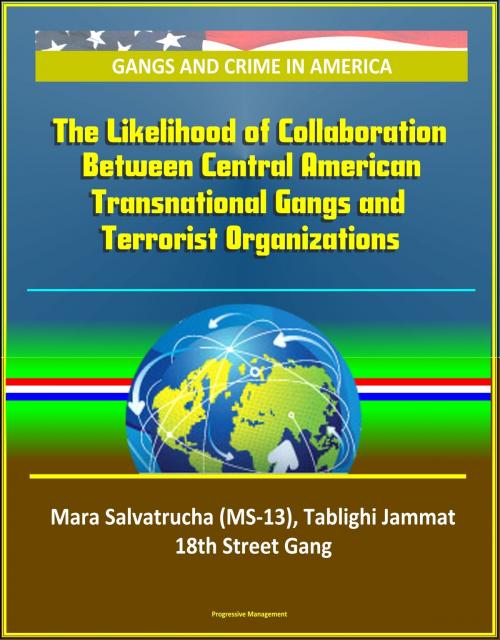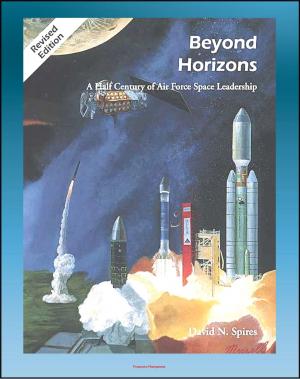Gangs and Crime in America: The Likelihood of Collaboration Between Central American Transnational Gangs and Terrorist Organizations - Mara Salvatrucha (MS-13), Tablighi Jammat, 18th Street Gang
Nonfiction, History, Americas, Central America, Social & Cultural Studies, Political Science| Author: | Progressive Management | ISBN: | 9781370071760 |
| Publisher: | Progressive Management | Publication: | April 22, 2017 |
| Imprint: | Smashwords Edition | Language: | English |
| Author: | Progressive Management |
| ISBN: | 9781370071760 |
| Publisher: | Progressive Management |
| Publication: | April 22, 2017 |
| Imprint: | Smashwords Edition |
| Language: | English |
This excellent report has been professionally converted for accurate flowing-text e-book format reproduction. This study focuses on the issue of the growing threat of transnational criminal gangs spreading throughout the Central America and the United States (U.S.). More specifically, the study addresses the Mara Salvatrucha (MS-13) gang, examining how this particular gang emerged as a formidable public security threat. A common misconception holds transnational gangs like MS-13 emerged in Central America; however, the truth is these gangs have their origins in the gang lifestyle found in the U.S. Since the early 1990's, MS-13 and similar transnational gangs have established criminal networks specializing in drug, arms, goods, and human smuggling. These operations pose a grave threat to U.S. national security: intelligence reports surfaced in 2004 indicating a possible meeting between an al-Qaeda lieutenant and members of MS-13. Due to these reports, U.S. agencies such as the Federal Bureau of Investigation and Immigration and Customs Enforcement are among the agencies that have started to work closely in monitoring transnational gang activity in the U.S. and the western hemisphere region. While MS-13 does not hold any anti-American sentiment, the gang will work with the highest bidder without hesitation. Therefore, the study addresses the organized crime-terrorist organization debate within the academic and intelligence communities, adding how globalization serves to facilitate such a link. The study helps to explain how current Central American legislation is forcing transnational gangs to go "underground" in order to survive. Findings show the need to switch towards a more multi-faceted strategy in order to ensure long-term solutions to the proliferation of transnational gangs not obtainable with current heavy-handed methods while concurrently reducing the risk of a terrorist-transnational gang link in the western hemisphere.
I. THE LIKELIHOOD OF COOPERATION * A. THE THREAT OF RISING CRIME * B. ATTRACTION TO TRANSNATIONAL GANGS * C. LITERATURE REVIEW: AN OVERVIEW * 1. Organized Crime and Terrorist Organization Link Debate * a. "Cooperation is Likely" School of Thought * b. "Cooperation is Unlikely" School of Thought * 2. Western Hemisphere's Transnational Gangs Problem * 3. Conclusion * D. RESEARCH DESIGN * II. ORGANIZED CRIME AND TERRORIST ORGANIZATIONS * A. INTRODUCTION * B. ORGANIZED CRIME * 1. Major Characteristics * a. Organizational Structures * b. Use of Violence * c. Secrecy * C. TERRORIST THAT REVERT TO CRIME * 1. Post Cold War Environment * 2. Alternate Avenues for Funding * a. Entry-Level Crime * b. Existing Networks * D. GLOBALIZATION * 1. Individual Level and Non-state Actors * 2. Regional Level * 3. National Level * 4. Globalization's Dark Side * a. Drugs * b. Arms Trafficking * c. Alien Smuggling * d. Money Laundering * e. Intellectual Property * E. OBSERVATIONS AND CONCLUSION * 1. Motivation as a Separator * 2. Terrorist-Criminal Link through Similarities * III. MARA SALVATRUCHA BACKGROUND * A. INTRODUCTION * B. CIVIL WARS: MARA SALVATRUCHA ORIGINS * C. ORGANIZATION * D. DEMOGRAPHICS * E. CURRENT THREAT * 1. El Salvador * 2. Honduras * 3. Southern Mexico * 4. United States * F. CONCLUSION * IV. CURRENT RESPONSES TO TRANSNATIONAL GANGS * A. INTRODUCTION * B. WHO OR WHAT IS TO BLAME * 1. Economic Liberalization * 2. Violence and Overwhelmed Police Forces * C. HEAVY HANDED RESPONSES: EL SALVADOR AND HONDURAS * 1. Citizenry Reception * 2. Critiques * a. Central American Prison Systems * b. Vigilante Organizations * D. ALTERNATIVE RESPONSES: NICARAGUA AND PANAMA * 1. Legislation * E. THE SEEMINGLY UNDECIDED: GUATEMALA * F. U.S.: CURRENT RESPONSE * G. CONCLUSION * V. CONCLUSION * A. WESTERN HEMISPHERE TRANSNATIONAL GANG-TERRORIST LINK IS PLAUSIBLE * B. RECOMMENDATIONS
This excellent report has been professionally converted for accurate flowing-text e-book format reproduction. This study focuses on the issue of the growing threat of transnational criminal gangs spreading throughout the Central America and the United States (U.S.). More specifically, the study addresses the Mara Salvatrucha (MS-13) gang, examining how this particular gang emerged as a formidable public security threat. A common misconception holds transnational gangs like MS-13 emerged in Central America; however, the truth is these gangs have their origins in the gang lifestyle found in the U.S. Since the early 1990's, MS-13 and similar transnational gangs have established criminal networks specializing in drug, arms, goods, and human smuggling. These operations pose a grave threat to U.S. national security: intelligence reports surfaced in 2004 indicating a possible meeting between an al-Qaeda lieutenant and members of MS-13. Due to these reports, U.S. agencies such as the Federal Bureau of Investigation and Immigration and Customs Enforcement are among the agencies that have started to work closely in monitoring transnational gang activity in the U.S. and the western hemisphere region. While MS-13 does not hold any anti-American sentiment, the gang will work with the highest bidder without hesitation. Therefore, the study addresses the organized crime-terrorist organization debate within the academic and intelligence communities, adding how globalization serves to facilitate such a link. The study helps to explain how current Central American legislation is forcing transnational gangs to go "underground" in order to survive. Findings show the need to switch towards a more multi-faceted strategy in order to ensure long-term solutions to the proliferation of transnational gangs not obtainable with current heavy-handed methods while concurrently reducing the risk of a terrorist-transnational gang link in the western hemisphere.
I. THE LIKELIHOOD OF COOPERATION * A. THE THREAT OF RISING CRIME * B. ATTRACTION TO TRANSNATIONAL GANGS * C. LITERATURE REVIEW: AN OVERVIEW * 1. Organized Crime and Terrorist Organization Link Debate * a. "Cooperation is Likely" School of Thought * b. "Cooperation is Unlikely" School of Thought * 2. Western Hemisphere's Transnational Gangs Problem * 3. Conclusion * D. RESEARCH DESIGN * II. ORGANIZED CRIME AND TERRORIST ORGANIZATIONS * A. INTRODUCTION * B. ORGANIZED CRIME * 1. Major Characteristics * a. Organizational Structures * b. Use of Violence * c. Secrecy * C. TERRORIST THAT REVERT TO CRIME * 1. Post Cold War Environment * 2. Alternate Avenues for Funding * a. Entry-Level Crime * b. Existing Networks * D. GLOBALIZATION * 1. Individual Level and Non-state Actors * 2. Regional Level * 3. National Level * 4. Globalization's Dark Side * a. Drugs * b. Arms Trafficking * c. Alien Smuggling * d. Money Laundering * e. Intellectual Property * E. OBSERVATIONS AND CONCLUSION * 1. Motivation as a Separator * 2. Terrorist-Criminal Link through Similarities * III. MARA SALVATRUCHA BACKGROUND * A. INTRODUCTION * B. CIVIL WARS: MARA SALVATRUCHA ORIGINS * C. ORGANIZATION * D. DEMOGRAPHICS * E. CURRENT THREAT * 1. El Salvador * 2. Honduras * 3. Southern Mexico * 4. United States * F. CONCLUSION * IV. CURRENT RESPONSES TO TRANSNATIONAL GANGS * A. INTRODUCTION * B. WHO OR WHAT IS TO BLAME * 1. Economic Liberalization * 2. Violence and Overwhelmed Police Forces * C. HEAVY HANDED RESPONSES: EL SALVADOR AND HONDURAS * 1. Citizenry Reception * 2. Critiques * a. Central American Prison Systems * b. Vigilante Organizations * D. ALTERNATIVE RESPONSES: NICARAGUA AND PANAMA * 1. Legislation * E. THE SEEMINGLY UNDECIDED: GUATEMALA * F. U.S.: CURRENT RESPONSE * G. CONCLUSION * V. CONCLUSION * A. WESTERN HEMISPHERE TRANSNATIONAL GANG-TERRORIST LINK IS PLAUSIBLE * B. RECOMMENDATIONS















